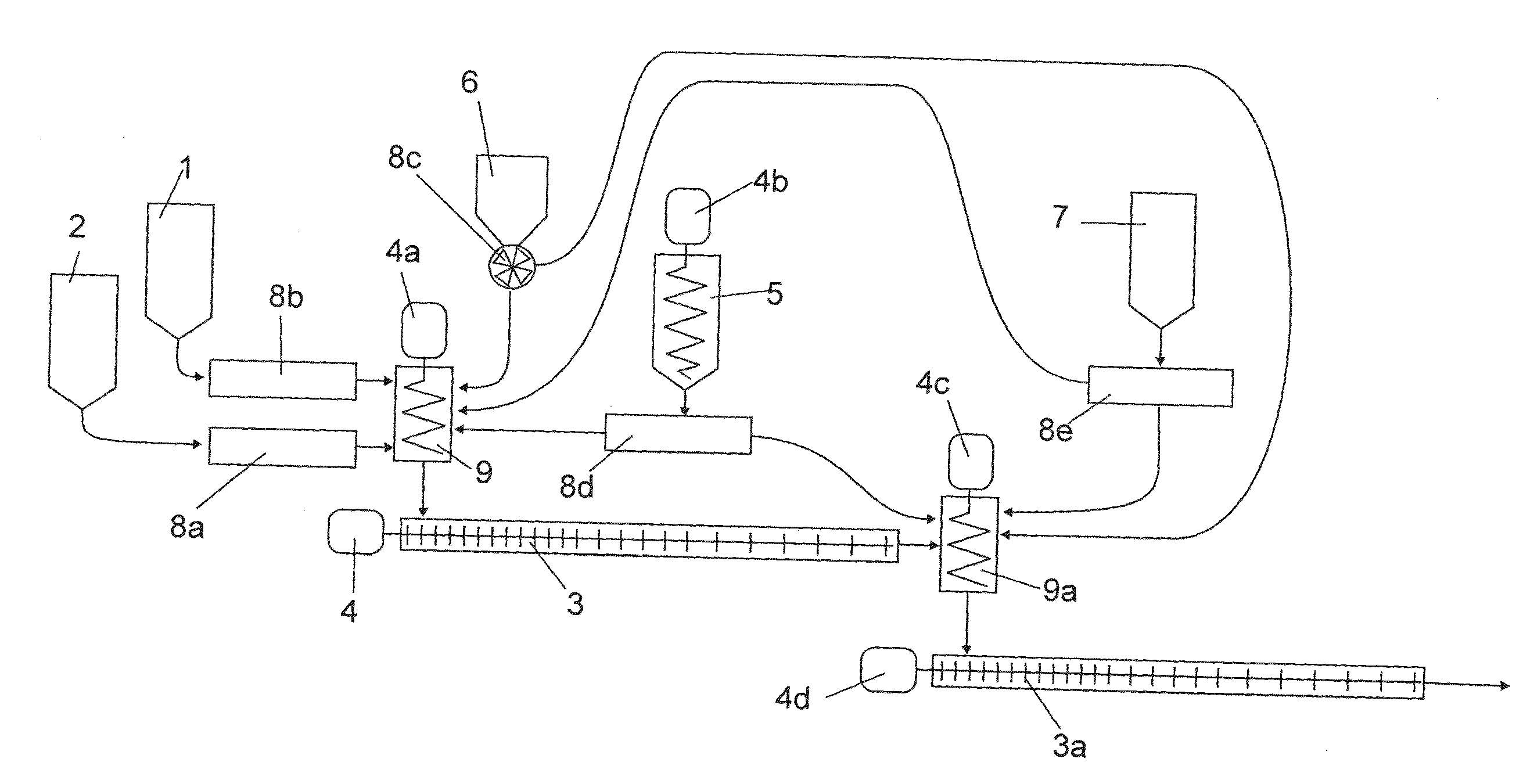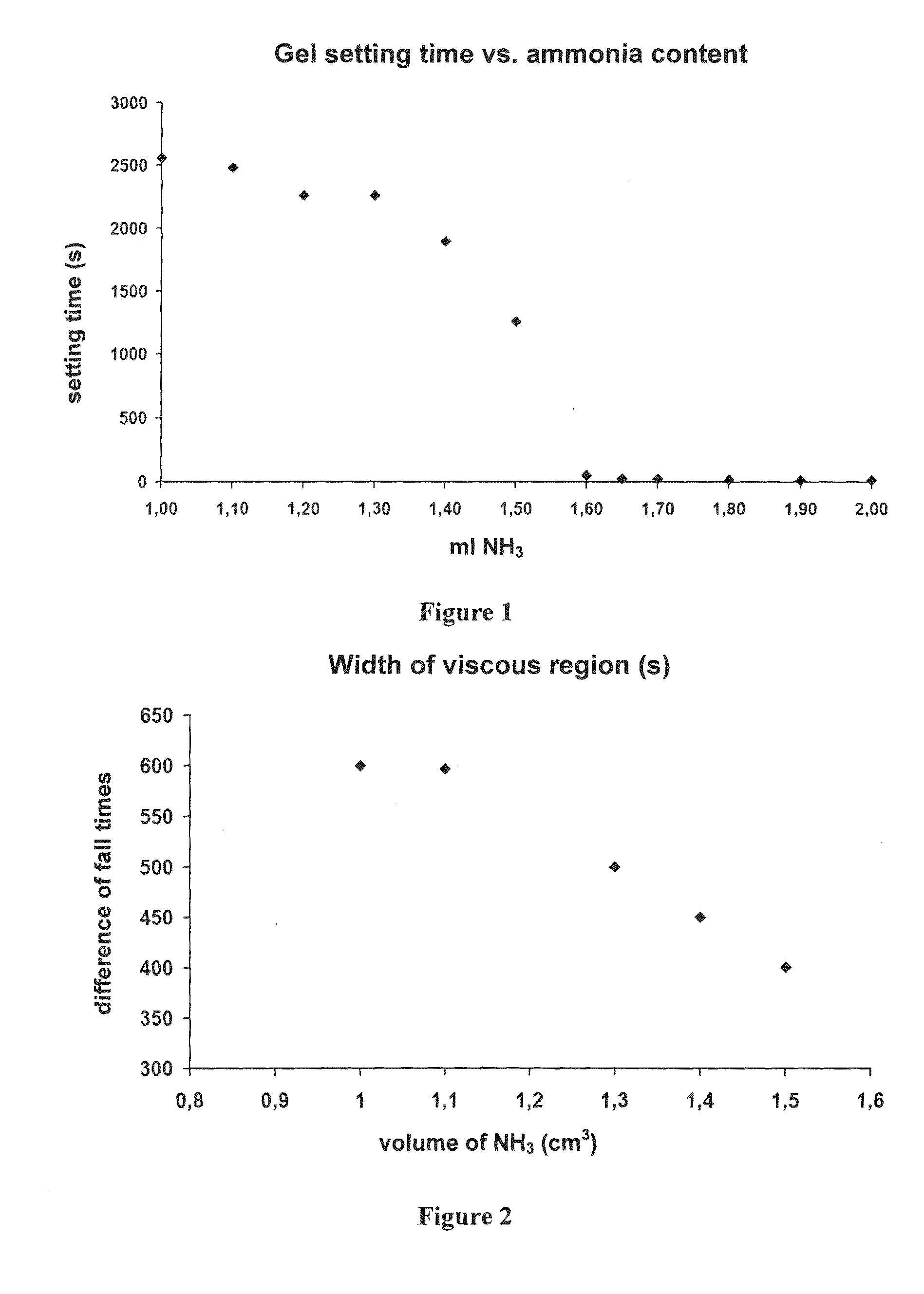Method for the preparation of composite silica alcogels, aerogels and xerogels, apparatus for carrying out the method continuously, and novel composite silica alcogels, aerogels and xerogels
a technology of composite silica alcogels and aerogels, which is applied in the direction of inorganic non-active ingredients, inorganic carriers, nuclear elements, etc., can solve the problems of significant restriction of xerogels, reduced specific area, and increased density, and achieves the effect of slowed gelation
- Summary
- Abstract
- Description
- Claims
- Application Information
AI Technical Summary
Benefits of technology
Problems solved by technology
Method used
Image
Examples
example 1
Study of the Gelation Retarding Effect of Urea
[0191]During studying the gelation of the alcogel formed by base catalyzed hydrolysis of tetramethoxysilane (TMOS), we unexpectedly found that in the constant volume reaction mixture the time for the alcogel becoming self-supporting does not decrease linearly with the amount of the base catalyst added, as expected, but it changes as shown in FIG. 1, as a function of the volume of the base catalyst added (FIG. 1).
[0192]In these studies, the base catalyst was 1:1 v / v diluted 25% NH3 solution.
[0193]The term “constant volume” in these studies means that the sum of the volumes of the methanol used as solvent and the silane reagent (e.g. tetramethoxysilane, abbreviated: TMOS), and the volume of the water and the 1:1 diluted ammonia solution was usually constant both pair-wise and combined, typically 15 ml.
[0194]In a typical series of experiments, the following solutions were used in the studies. Solution “A”: 7.50 ml methanol, 0.80-0.90 ml wat...
example 2
Variation of Gelation Time in Response to Different Additives
[0204]Based on the observations of Example 1, we carried out further experiments.
[0205]We measured in a series the effect of different substances on the gel-setting time, and obtained the approximate gel-setting time values shown in Table 1 below: (Conditions: 1.00 ml (or 1.00 g for solids) additive / 5.00 ml MeOH stock solution. Solution “A”: 1.00 ml additive stock solution+10 ml MeOH, 1.50 ml TMOS; Solution “B”: 0.80 ml water+1.70 ml 1:1 diluted NH3 solution.)
TABLE 1added substancegelation timewithout additive18-19sDMF260sDMSO1130surea740sethylene glycol120spropylene glycol25sglycerol24sethanol18-19s (no gelation retarding effect)1-propanol18-19s (no gelation retarding effect)1-butanol18-19s (no gelation retarding effect)
[0206]In another series, significant viscosity increasing effect was also observed at different concentrations. (Solution “A”: 6.0 ml of the additive examined+1.50 ml TMOS; Solution “B”: 5.0 ml methanol+1....
example 3
Study of the Gelation Retarding Effect of DMSO
[0210]A more detailed study was performed with the additive DMSO, in which the changes were studied in function of the amount of catalyst. The results are shown in FIG. 5. The figure shows the apparent gel-setting time as a function of the volume of added DMSO additive in constant final volume compositions. Depending on the volume ratio of TMOS / concentrated NH3, the same amount of DMSO shows a viscosity increasing effect with different characteristics. The solutions used:
[0211]Solution “A”: 50.0 ml MeOH+15.00 ml TMOS.
[0212]Solution “B”: 50.0 ml MeOH+17.00 ml 1:1 diluted 25% NH3 solution+8.00 ml H2O.
[0213]Additive solution: x ml DMSO+(1-x) ml MeOH.
[0214]The horizontal axis shows volume x of DMSO in the figure.
[0215]Compositions:
[0216]At the ratio of TMOS / conc. NH3=2.35: 7.50 ml Solution “A”+6.50 ml Solution “B”+1.00 ml DMSO additive solution.
[0217]At the ratio of TMOS / conc. NH3=1.76: 6.50 ml Solution “A”+7.50 ml Solution “B”+1.00 ml DMSO ...
PUM
| Property | Measurement | Unit |
|---|---|---|
| viscosity | aaaaa | aaaaa |
| density | aaaaa | aaaaa |
| size | aaaaa | aaaaa |
Abstract
Description
Claims
Application Information
 Login to View More
Login to View More - R&D
- Intellectual Property
- Life Sciences
- Materials
- Tech Scout
- Unparalleled Data Quality
- Higher Quality Content
- 60% Fewer Hallucinations
Browse by: Latest US Patents, China's latest patents, Technical Efficacy Thesaurus, Application Domain, Technology Topic, Popular Technical Reports.
© 2025 PatSnap. All rights reserved.Legal|Privacy policy|Modern Slavery Act Transparency Statement|Sitemap|About US| Contact US: help@patsnap.com



